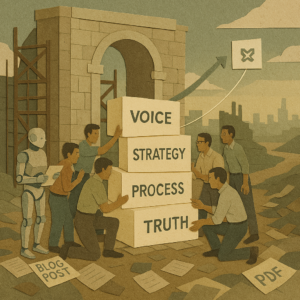Let’s say the quiet part out loud:
Most content doesn’t convert because it avoids the hard stuff.
It paints a rosy picture. Explains the benefits. Maybe even drops a few stats.
But it dodges the friction. The hesitation. The “Yeah, but…”
And that’s where trust actually begins.
If you’re leading marketing at a growing B2B company—especially one where sales is louder, sharper, or closer to the customer—you’ve probably heard those objections before. In Slack. In meetings. Maybe shouted across the room.
But are they showing up in your content?
Or are they still stuck in the sales team’s heads?
Because here’s the truth:
Objections are gold.
They’re not problems to avoid. They’re insight. Opportunity. Conversion waiting to happen.
And if you build your content around them, two things happen:
- You build trust faster than your competitors.
- Your content starts to actually help close deals.
Let’s break it down.
Objections Aren’t Roadblocks. They’re Roadmaps.
Salespeople know this instinctively. The best ones don’t just overcome objections—they invite them. They get the customer to lay all their doubts on the table. Because that’s when the real conversation starts.
So why do most marketing teams ignore them?
Usually, it’s a visibility problem. Marketing never hears the messy, real-world reasons deals stall. You get the highlight reel. Not the heat.
That’s a miss. Because those moments—those “But how does this work with our stack?” or “What if my team doesn’t adopt it?” questions—are exactly what prospects are typing into Google. Or asking in meetings. Or whispering to their boss after the demo ends.
The objection is the content.
Or at least, it should be.
“Objections are the voice of the customer telling you what they need to hear to say yes.”
— Amy Porterfield
That’s not just a nice quote. It’s a strategy.
Build a series around those voices—and you’ve got content that doesn’t just inform. It converts.
The Sales Page Isn’t the Only Place to Handle Resistance
Sure, great sales pages address FAQs.
But if that’s the only place you’re tackling objections, you’re late to the party.
By the time someone’s on your pricing page, they’ve already formed an opinion. You want to shape that thinking before they get there.
That’s what a well-built content series does.
It surfaces the friction early. It helps people self-identify. And it arms your sales team with content that meets prospects where they’re actually stuck—not where you wish they were in the funnel.
How to Build an Objection-Handling Content Engine (Without Burning Out)
This isn’t about producing 15 new blogs in a vacuum.
It’s about surfacing insight that already exists—and making it scale.
Here’s the Still Works playbook:
1. Start With Sales. (Always.)
If you’re guessing at what objections exist, you’re already behind.
Sit down with your sales team. Or better yet—listen to Gong calls. Scroll through their DMs. Ask:
- “What almost killed your last deal?”
- “What question keeps coming up in discovery?”
- “What do you wish marketing had content for?”
They’ll tell you. And if they’re not sure—ask again next week. This stuff shifts fast.
“Your sales team is your best focus group—listen to what they hear from customers every day.”
— Jill Konrath
2. Map Each Objection to a Core Idea
One objection = one core post.
This isn’t about writing rebuttals. It’s about telling the story behind the doubt.
For example:
- Objection: “It’s too complex for our team to adopt.”
→ Content: “Why most adoption plans fail—and how we design around them.” - Objection: “We’ve already tried something like this.”
→ Content: “What changed in 2024—and why it matters now.”
Keep it conversational. Keep it honest. Back it with lived experience.
3. Let Sales Use It, Not Just Share It
This part matters.
Don’t just publish your post and hope someone shares it.
Personalise it.
Use AI (hey, that’s what we do) or a junior marketer to rework it into:
- A LinkedIn post in each rep’s voice
- A short DM follow-up after a call
- A tailored section for your sales deck
Because when content sounds like them, they’ll actually use it.
“The best marketing ideas come from the front lines—where the customer meets the company.”
— Michael Dell
4. Revisit and Refine, Fast
Once the post is live, don’t move on. Ask:
- Did sales use it?
- Did it shift conversations?
- What didn’t land?
Then sharpen it. Repurpose it. Make version two.
Remember: Velocity beats volume.
One sharp idea, travelling further in more voices, will always beat ten lifeless blog posts.
Why This Works (Even If It Feels Basic)
Because customers don’t need more white papers.
They need to feel understood.
And nothing says “we get you” like naming the fear before they do.
“The best way to overcome an objection is to anticipate it and address it before it’s even raised.”
— Brian Tracy
That’s not just good sales advice.
That’s a content strategy.
TL;DR – What to Do Next
Here’s your starting point:
- Book 30 minutes with sales. Ask what’s holding deals back.
- Turn one objection into one blog. Make it specific, lived-in, and real.
- Give sales a version in their voice. And track what happens.
- Repeat. Refine. Repurpose. Then do it again.
This is how content builds trust.
This is how marketing becomes revenue-aligned.
This is how your blog stops gathering dust.
Let’s go kill the fluff—and publish what prospects actually need to hear.


